Proactive Displays & The Experience UbiComp ProjectOverviewProactive displays are large computer displays augmented with sensors that can detect people nearby and show content relating to those people. A proactive display creates a bridge between a person's digital content, such as a personal web site or online photo collection, and his or her presence in the physical world. The goal is to enable us to easily share the richness of our digital lives with our neighbors in physical space, creating new opportunities for greater awareness and interactions by bringing the benefits of virtual communities into physical communities. While we don't believe everyone wants to share everything about themselves everywhere they go, we do believe that there are many times and places where people would be willing, and even eager, to share something. Experience at UbiComp 2003A conference provides an ideal context in which to explore the use of proactive displays, as attendees come together for the purpose of mutual revelation, eager both to learn more about others and what others are doing and to tell others about themselves and what they are doing. We designed, implemented, deployed and evaluated a suite of proactive display applications that we deployed at a recent conference (UbiComp 2003) to aid and abet this desire for mutual revelation in the context of a paper presentation session, a demonstration and poster session, and informal break areas at a conference. Participants created a profile containing any subset of the following types of information:
This profile information could then be associated with an RFID tag that participants could put in their conference badge sleeve. Different proactive display applications would respond in different ways when RFID tags worn by attendees were detected. Three ApplicationsAutoSpeakerID displayed the photograph, name and affiliation of someone asking a question at the microphone stand during the question and answer period following a paper or panel presentation, visually augmenting the common oral practice of introducing oneself before asking a question. 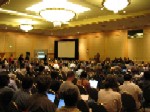
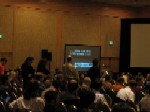
Ticket2Talk displayed an image representing some interest explicitly specified in the profile of someone in the coffee break area, providing a "ticket to talk" with that person about that interest while they were nearby. 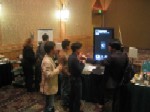

Neighborhood Window displayed a participant's name and picture, along with words and phrases found on that person's homepage, in the lounge area of the demonstration session. If other participants were nearby, their name and picture was also displayed, along with words and phrases from their homepages; words and phrases shared by the group of participants gathered near the display were highlighted, with links between the people and their associated words. 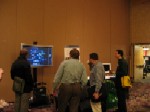
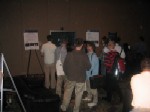
Publications and Presentations
Proactive Displays: Supporting Awareness in Fluid Social Environments
Augmenting the Social Space of an Academic Conference |